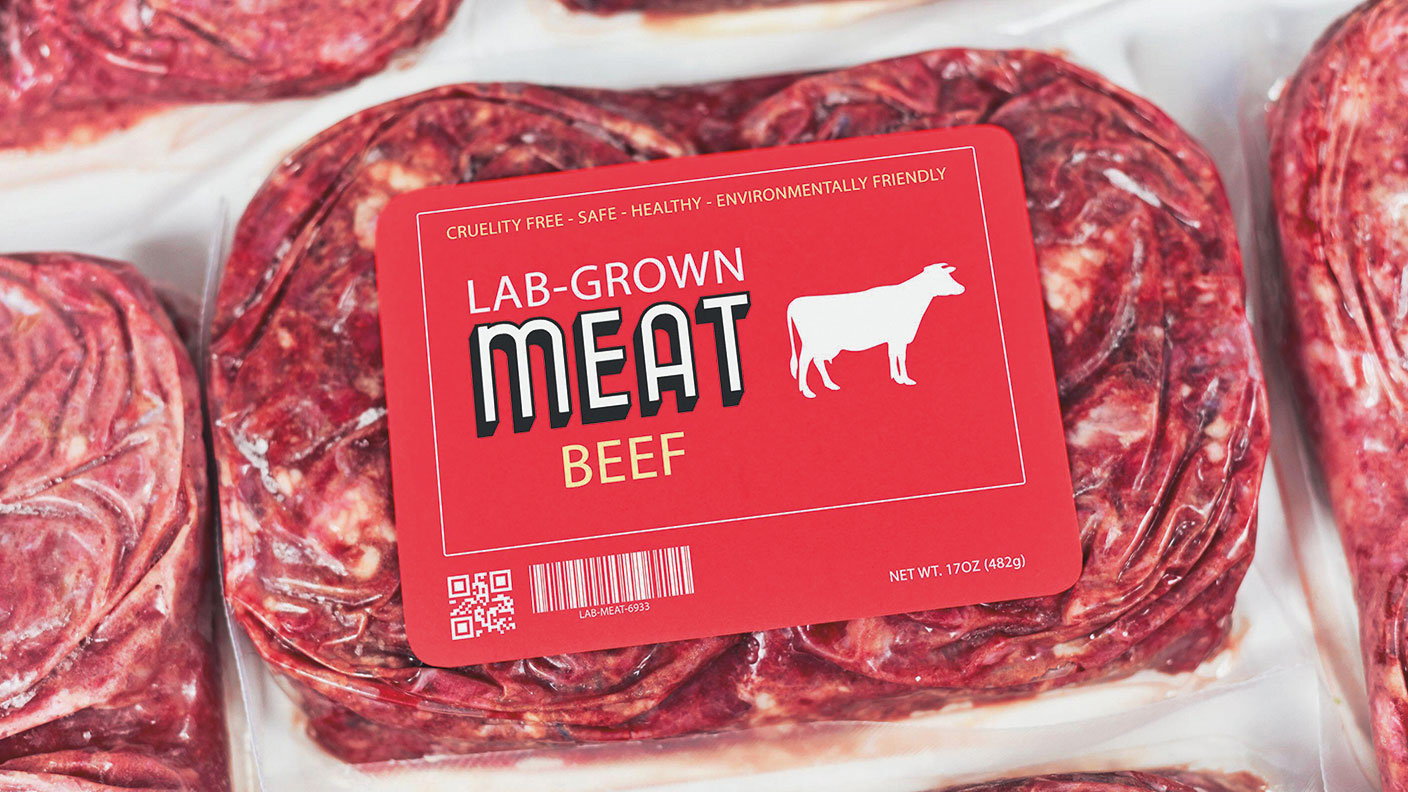Lab-grown meat: how “moo’s law” will drive innovation
Jim Mellon and Anthony Chow, co-founders of Aim-listed Agronomics, explain why they believe that “cellular agriculture” will benefit from massive long-term growth as “Moo’s Law” kicks in.

About three years ago, we became interested in prospects for what’s known as “cellular agriculture”, and the two of us founded Agronomics, via a listed Aim shell company. The shares have done very well, as investors have learned more about the prospects for making food and materials in laboratories and factories, without animal cruelty and slaughter. However, the industry is still nascent. We’d consider it as perhaps being at the equivalent of the dial-up phase of the internet, which means that prospects for super-charged growth are excellent.
Here are some “back of an envelope” predictions. The dairy industry as we know it today (with cows in sheds being milked almost continuously and generally in abject circumstances) will be gone in 15 years. Alternative milks, such as almond, soya and oat milks – Swedish company Oatly is about to go public with a rumoured $10bn valuation – are already gobbling up market share from traditional producers.
These plant-based milks are not necessarily better for either human health or for the environment. For example, almond production uses prodigious amounts of water. But these plant-based milks are just the vanguard of what will be the main disrupting force in the production of dairy products (milk, cheese, yoghurts and infant formula). This will come from precision fermentation, where casein and whey are replicated in laboratory-like conditions, by companies such as Perfect Day, Legendairy and NoQuo. These companies’ products will be effectively replicas of “normal” dairy products. And they will be in widespread use within three years.
MoneyWeek
Subscribe to MoneyWeek today and get your first six magazine issues absolutely FREE

Sign up to Money Morning
Don't miss the latest investment and personal finances news, market analysis, plus money-saving tips with our free twice-daily newsletter
Don't miss the latest investment and personal finances news, market analysis, plus money-saving tips with our free twice-daily newsletter
Going beyond Beyond Meat
Then take meat and fish – any meat, any fish, any species. All of the companies we have in our Agronomics portfolio have prototypes that you can eat or, in the case of materials, feel. Some of these companies will be selling their products to consumers within a year or so. This is despite lobbying from what we call “the agro Luddites”, who are resisting the progress of lab-grown meat and fish. We are confident that half of all meat in the world will be plant-based or cellular-agriculture-based within ten years, and in the case of fish, possibly sooner.
MoneyWeek readers will be familiar with the march of plant-based meats in recent years. Beyond Meat has already gone public in the US, with a valuation of more than $9bn and it is rumoured that its great rival, Impossible, will shortly be going public via a special purpose acquisition company (SPAC) at a valuation of about $10bn. In the UK, home-grown companies such as Meatless Farms and Quorn are seeing rapid growth. In Europe, one of our favourites, LiveKindly, is doing well with its chicken substitutes.
But the really exciting opportunity for us is in lab-grown foods and materials, and not so much in plant-based ones. Why? For one thing, the cellular-agriculture companies typically have more intellectual property than the plant-based companies. For another, ultimately, we believe that at scale the products of the cellular-agriculture companies can be priced more cheaply than conventional foods (hence the title of Jim’s recent book, Moo’s Law, a riff on Moore’s Law, which refers to the process by which computers become more powerful even as costs decrease). Jim calls the point at which the price of alternative foods falls to that of conventional foods “griddle parity” (another riff, this time on “grid parity” in the energy industry). For plant-based foods, this might be as soon as next year in some cases, and in cellular-agriculture-based foods, maybe in five years’ time.
The power of griddle parity
“Griddle parity” is key. Some informed and committed consumers are influenced by the environmental destruction wrought by intensive farming and fishing, by the pandemic risks posed by animal husbandry (80% of all antibiotics go into animals), and by animal cruelty. But the reality is that most consumers care about four things: taste, texture, convenience and price. As far as the first three go, there is already no difference between cellular-agriculture products and those from conventional seafood or meat companies. But when it comes to price, cellular-agriculture processes are currently expensive because they use biotech inputs.
However, that is changing. The costs of the bioreactors, the “media” (the feedstock to grow the cells needed to produce the meat, seafood and materials) and growth factors needed to fast track the production of the foods and products, are coming down. There are remarkable investment opportunities in this field, but as yet nothing is public in the sector apart from Agronomics in London.
Its investments include BlueNalu, a cellular-agriculture seafood company, which will be in the US market by the end of this year. Then there is VitroLabs, which produces and sells leather of the highest quality, none of which comes from a cow (except for the progenitor stem cells). Meanwhile, Legendairy will shortly be producing mozzarella, again without resort to animals. The list goes on. We estimate that the total addressable market for the foods, seafood, and materials that we are investing in is around $5trn – about twice the size of the UK economy. You can see why we’re excited about this opportunity.
Get the latest financial news, insights and expert analysis from our award-winning MoneyWeek team, to help you understand what really matters when it comes to your finances.
-
 The best real estate opportunities to invest in for 2026
The best real estate opportunities to invest in for 2026House price growth may be slowing but offices and online shopping are driving growth in real estate investment
-
 Asia's new tiger economy: MoneyWeek Talks
Asia's new tiger economy: MoneyWeek TalksPodcast MoneyWeek's editor, Andrew van Sickle, speaks to Dragon Capital's Thuy-Anh Nguyen about Vietnam's remarkable rise
-
 Leading European companies offer long-term growth prospects
Leading European companies offer long-term growth prospectsOpinion Alexander Darwall, lead portfolio manager, European Opportunities Trust, picks three European companies where he'd put his money
-
 How to harness the power of dividends
How to harness the power of dividendsDividends went out of style in the pandemic. It’s great to see them back, says Rupert Hargreaves
-
 Why Trustpilot is a stock to watch for exposure to the e-commerce market
Why Trustpilot is a stock to watch for exposure to the e-commerce marketTrustpilot has built a defensible position in one of the most critical areas of the internet: the infrastructure of trust, says Jamie Ward
-
 Tetragon Financial: An exotic investment trust producing stellar returns
Tetragon Financial: An exotic investment trust producing stellar returnsTetragon Financial has performed very well, but it won't appeal to most investors – there are clear reasons for the huge discount, says Rupert Hargreaves
-
 How to capitalise on the pessimism around Britain's stock market
How to capitalise on the pessimism around Britain's stock marketOpinion There was little in the Budget to prop up Britain's stock market, but opportunities are hiding in plain sight. Investors should take advantage while they can
-
 London claims victory in the Brexit wars
London claims victory in the Brexit warsOpinion JPMorgan Chase's decision to build a new headquarters in London is a huge vote of confidence and a sign that the City will remain Europe's key financial hub
-
 Reinventing the high street – how to invest in the retailers driving the change
Reinventing the high street – how to invest in the retailers driving the changeThe high street brands that can make shopping and leisure an enjoyable experience will thrive, says Maryam Cockar
-
 The consequences of the Autumn Budget – and what it means for the UK economy
The consequences of the Autumn Budget – and what it means for the UK economyOpinion A directionless and floundering government has ducked the hard choices at the Autumn Budget, says Simon Wilson